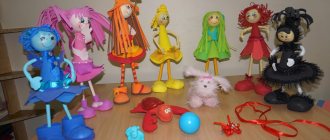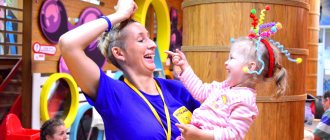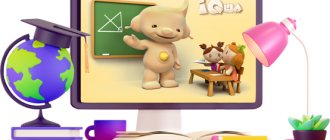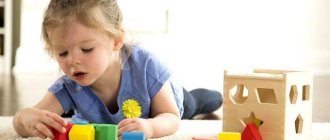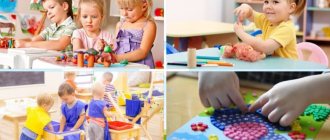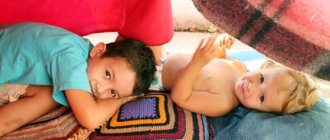"Me and my health." Valeological games and exercises
According to the World Health Organization, “health is a state of complete physical, mental and social well-being and not merely the absence of disease or injury.”
A number of factors influence a child’s health:
- heredity (share of influence is 20%)
- environmental impact (share of influence - 20%)
- medical care (share of influence - 10%)
- lifestyle (share of influence - 50%).
These data force us to pay the most serious attention to the fourth group of factors. It consists of the child’s attitude to his health, his nutrition, adherence to the daily routine, physical activity, hardening, proper sleep, and mastery of hygiene skills. The games and exercises offered in this section will help children develop the right attitude towards their health.
Who do I look like? Goal: developing the ability to look at oneself from the outside, compare a person with other animal organisms, find similarities and differences, promote the development of imagination.
Material: photographs of parents, other close relatives of children, prizes.
Description: invite children to carefully look at the photographs and find similar features. The one who finds the most signs wins a prize.
Who was born
Goal: to consolidate children’s ideas about how living beings are born.
Equipment: three large pictures depicting an egg, caviar, a bottle of milk and a pacifier; small pictures depicting people, animals, birds, amphibians, insects.
In front of the children are pictures with animals, insects, amphibians, and people turned upside down. Children choose any picture and tell how this creature was born. Then they combine a small picture with a large one - with the image of an egg, an egg, a bottle with a nipple (for mammals).
Gardener
Goal: familiarization with the external structure of the human body, to develop the ability to see the good in other people.
Description: children stand in a circle, the leader is the gardener in the center. He utters the following words: “I was born a gardener, I was seriously angry, I was tired of all the flowers, except for Yulenka! “Then the “gardener” talks about Yulenka’s virtues. Then Yulenka becomes the leading gardener. She chooses one of the guys and tells why he (s) is good, thus explaining her choice.
Name it correctly
Goal: to consolidate knowledge about hygiene products, their purpose and correct use.
Material: subject pictures of various subjects, including images of hygiene products, chips.
Description: children choose from a variety of items those that help them take care of themselves. For example: “I wash my face” (what objects help you with this), “I take a shower,” etc. For the right choice - a trick.
Choose clothes according to the seasons
Goal: developing the ability to distinguish items of clothing depending on the time of year.
Material: items of clothing used in different seasons, 4 dolls.
Description: children are divided into teams, each of which “dresses” its doll for a certain time of year.
Who needs what to live?
Goal: consolidation of knowledge and ideas about the basic needs of living organisms for warmth, air, food, habitat.
Material: cards depicting living beings (human, dog, tree, flower, etc.; cards depicting food, habitat.
Description: invite children to choose a pair for each card, answering the questions - choose what the bird needs to live? What does a dog need so that it can live.
Who am I?
Goal: expanding the child’s knowledge about himself, his name, his surname, age.
Equipment: mirror; subject pictures depicting animals and birds.
Tell us what you know about yourself (name, age, height, hair color and length, eye color, date of birth, girl or boy).
Tell me who you are like: mom or dad.
Do you have signs that are present in any animal or bird?
Health traffic light
Goal: developing ideas about a healthy lifestyle.
Material: circles of red, yellow, green colors, subject pictures.
Description: offer to “light” the health traffic light. The green circle is what helps a person lead a healthy lifestyle; yellow is something that needs to be treated with caution, red circle is something that is harmful to health.
Name the athlete
Goal: to develop a respectful attitude towards athletes, to develop the ability to distinguish and name sports.
Material: pictures of athletes.
Goal: to develop a respectful attitude towards athletes, to develop the ability to distinguish and name sports.
Description: Children play in pairs. One takes a picture of an athlete and shows the given sport with a movement, the other guesses. Then the players change places.
Where are the vitamins hidden?
Goal: to consolidate the understanding of vitamin groups, their importance and health benefits.
Material: baskets with letters indicating groups of vitamins (A, B, C); dummies of fruits and vegetables.
Description: suggest placing the dummies in baskets with the corresponding group of vitamins.
What first - what then (daily routine)
Goal: to reinforce the idea that following a proper daily routine is good for health.
Material: plot pictures depicting actions characteristic of a certain period of the day.
Description: invite players to arrange the pictures in the correct sequence and explain their choice.
Sun, air and water are our faithful friends
Goal: to form an idea about the means and types of hardening (water, air, solar), their importance for health.
Material: story pictures.
Description: children look at the pictures and determine what health benefits the sun, air and water bring. The one who names the most useful properties wins.
Why did the guys get sick?
Goal: to develop the ability to identify cause-and-effect relationships, cultivate a caring attitude towards one’s health, and develop coherent speech.
Material: plot pictures depicting correct and incorrect actions (leading to illness).
Description: children choose pictures depicting incorrect actions and explain their choice.
Name it correctly (medicines)
Goal: familiarize yourself with the names of medications that are used for treatment and which are part of the “home medicine cabinet.”
Material: pictures depicting medications included in the “home first aid kit”, “first aid kit”.
Description: children are invited to assemble a “home first aid kit”, naming medications, and explain their choice.
Choose medicinal plants
Goal: familiarize yourself with the names of medications that are used for treatment and which are part of the “home medicine cabinet.”
Material: subject pictures depicting plants, “Aibolit” doll.
Description: children choose medicinal plants from all the proposed pictures, and “Aibolit” explains what medicinal properties they have.
How should you take care of yourself?
Goal: developing skills to monitor compliance with personal hygiene rules.
Equipment: top, chips, cards with questions.
The presenter spins the top, which determines the card with the question. For the correct answer, the child receives a chip. The one with the most chips wins.
Questions
1. Name the items you need for washing (soap, towel).
2. Name the items you will need to take a shower (shampoo, soap, shower gel).
3. How often should you wash? (Every day).
4. How often should you brush your teeth? (In the morning and in the evening).
5. How often should you cut your nails? (At least once every 10 days).
6. How often should you wash your ears? (Every day).
7. How often should you change your underwear? (Every day).
Show me and I'll guess
Goal: to develop a respectful attitude towards athletes, to develop the ability to distinguish and name sports.
Description: one subgroup of children, using specific movements, shows (makes a guess) what kind of sport they are involved in. Another subgroup guesses who was depicted (skier, swimmer, hockey player, gymnast, etc.).
Good words
Goal: to create a desire to see the good in other people, the development of speech and imagination.
Description: children stand in circles, pass the ball around the circle, name one of the good qualities of their neighbor or call him by an affectionate name.
Making a menu
Goal: developing the idea that health depends on proper nutrition - food should not only be tasty, but also healthy.
Material: play dishes, dummies of fruits, vegetables, food.
Description: The presenter tells the players: “In front of you is a table set for lunch (dinner). Put in the first plate what you want to eat first, then fill the second plate, and the dessert bowl. Mark those players who filled their plates with more than just sweets, and who “created a menu” that is healthy.
To keep your skin healthy
Goal: developing skills to monitor compliance with personal hygiene rules.
Equipment: pictures marked with a red rim with incorrect actions of children.
Children look at the pictures and find what is wrong. For the correct answer, the child receives a chip. The one with the most chips wins.
Images
The child licks abrasions and cuts.
Boy in dirty underwear.
The girl puts on someone else's shoes.
What do we know about things?
Goal: to expand children’s understanding of the rules of safe behavior at home; develop attention and memory; foster a sense of cooperation.
Material: four playing cards depicting a cut, burn, hand bruise and fire; pictures depicting various household items.
Description: 4 children take part in the game, each of them takes a game card with the image of an “injury”. The teacher (child) is the leader. He picks up a picture of an object one by one. Participants must guess what injury could result from improper handling of this item, match it to their card and take the picture. When selecting, the child must explain why this or that object is dangerous and tell the rules for handling it.
Author: Olga Vladimirovna Mozdukova, teacher at MBDOU “Kindergarten No. 3”, Belovo, Kemerovo region, Russia.
The article is published in the author's edition.
Card index of didactic games on valeology
CARD FILE OF DIDACTIC GAMES ON VALEOLOGY
For children of senior preschool age
Where does the vitamin live?
Didactic task:
introduce children to the types of vitamins and their sources.
Game rules:
You need to choose a picture and name what vitamins are in this fruit or vegetable.
Game actions:
selecting cards and matching them with the image of a vegetable or fruit.
Progress of the game
:
The teacher invites the children to divide into two teams. The player of the first team shows the vitamin, and the players of the other team show pictures of vegetables and fruits that contain it. Then it’s the other way around: the player of the second team shows a picture of a fruit or vegetable, and the players of the first team name the vitamins that it contains and show the corresponding picture.
What does the heart love?
Didactic task:
instill the habit of a healthy lifestyle, broaden children’s horizons on the prevention of heart disease.
Game rules:
You need to name the type of product or type of activity that is good for the heart.
Game actions:
naming words and connecting parts of the heart into a whole.
Progress of the game:
The teacher asks the children to name types of foods and activities that are good for the heart. Each named word is a part of the heart. Gradually, as children name words, a whole heart is formed. Number of players 8-10 people.
The morning begins...
Didactic task:
to accustom children to following a daily routine, to consolidate activities carried out at different times of the day.
Game rules:
It is necessary to name the activities carried out in the morning, afternoon, evening, and night.
Game actions:
choosing pictures and naming activities corresponding to morning, afternoon, evening and night.
Progress of the game:
The teacher invites the children to choose a picture of the time of day and name the corresponding activities that need to be carried out at this time of day and arrange the cards in the sequence in which they should be performed. Number of players 8-10 people.
Health watch
Didactic task:
consolidate children's knowledge about harmful and healthy foods and activities.
Game rules:
You need to scroll the arrows on the “health clock” and determine the usefulness or harmfulness of the image.
Game actions:
determining the usefulness or harmfulness of an image in a picture.
Progress of the game:
Option 1. The teacher invites the children to take turns scrolling the arrows on the “health clock”, while periodically saying: “Stop.” The player stops the arrow on the “health clock”, looks at the image to which it is directed and talks about the usefulness or harmfulness of what is in the picture. Number of players 8-10 people.
Option 2. Combine the two circles of the clock and match the options for the pictures. For example, during class, do not shout or watch TV for a long time before going to bed.
Health tree
Didactic task:
consolidate children's knowledge about harmful and healthy foods.
Game rules:
You need to distribute the pictures on the pieces of paper into the corresponding trees.
Game actions:
determining the usefulness or harmfulness of an image in a picture.
Progress of the game:
The teacher invites the children to divide into two teams, choosing a tree of “health” or a tree of “illness” and turns on light music.
While the music is playing, the children hang leaflets with pictures on the corresponding trees. When the music stops, the teacher sums up the task. Number of players 8-10 people.
Health with indoor plants
Didactic task:
consolidate children's knowledge about indoor plants, their names and beneficial properties.
Game rules:
You need to choose from a number of pictures pictures of indoor plants, name them and list their beneficial properties.
Game actions:
naming the plant and determining its usefulness.
Progress of the game:
The teacher invites the children to choose inverted pictures one by one. Having examined the image in the picture, the child needs to name the houseplant and list its beneficial properties. After completing the task, the child receives a chip. The one with the most chips wins. Number of players 8-10 people.
Be healthy
Didactic task:
form the habit of a healthy lifestyle, consolidate children’s knowledge about healthy products and activities.
Game rules:
You need to choose a picture depicting a food product and a type of activity in turn and correlate them with each other.
Game actions:
correlation of food product with type of activity.
Progress of the game:
The teacher invites the children to choose, for example, a picture of a carrot and an athlete and correlate them with each other: the athlete chooses healthy vegetables for nutrition, etc. (Fig. 7). Number of players 8-10 people.
Health and color
Didactic task:
learn to create a certain mood for a certain type of activity using color.
Game rules:
It is necessary to correlate a certain color with a certain type of activity.
Game actions:
correlating color with the corresponding type of activity.
Progress of the game:
The teacher invites the children to choose a color and correlate it with the corresponding type of activity:
Red – exciting, energetic (classes, exams, sports);
Yellow – when the eyes work hard (writing, drawing, reading);
Blue, light blue – during intense physical activity (rest after physical activity); Purple – accelerates regeneration processes (fast healing after illness); Orange – to overcome lethargy (sing, dance); Green – to create a positive emotional background (bedroom, relaxation);
MY FACE
Goals:
Teach knowledge of yourself, your individuality. Teach children how to make a human face (using various objects). Develop fine motor skills of the hands. Reinforce children's concepts of color (blue, green, gray, brown eyes). Strengthen the idea of parts of the face; activate the vocabulary: eyes, mouth, lips, nose, eyebrows. Develop tactile sensations.
Material:
multi-colored braid, buttons, sticks, plasticine, sandpaper, velvet paper, foam rubber.
Content.
Using various materials, children make up a person or his face; give a descriptive story about the face, its shape, etc.
CLEAN HANDS
Goals:
Teach the sequence of actions of the washing process. Activate the dictionary: soap, washcloth, brush, towel. Form the need for compliance with personal hygiene rules. Teach practical development of healthy lifestyle skills.
Material:
pictures with rules, toiletries, small toys, three-dimensional animal figurines, labor items.
Content.
1st option
– the teacher invites the children to choose pictures that correspond to the rule when it is necessary to wash their hands, and according to the picture, find three-dimensional objects.
2nd option
– the teacher invites children to imitate the movements of the washing process (creativity and imagination develops).
LET'S TALK WITHOUT WORDS
Target.
Exercise children in understanding the meaning of certain gestures, postures, and facial expressions of a person.
Content.
The teacher invites the children to guess the meaning of his gestures
(greeting, farewell, threat
, etc.), facial expressions
(surprise, joy, anger
, etc.), posture
(confusion, fatigue, well-being
, etc.). Then the children are given the task of giving examples of using various gestures, changing posture and facial expressions in order to understand each other without words.
FIND A PAIR
Goals:
Exercise children in selecting identical plates, comparing their surfaces using tactile sensations (blindfolded).
Content.
Plates covered with foil, velvet paper, fur, flannel, silk, as well as metal and wooden plates are placed in front of the children. Children choose one plate at a time, and then take turns looking for the second one by touch.
Note.
The child must explain what helped him correctly identify different materials.
I CAN – I CAN’T
Goals:
Intensify children's attention to their skills and physical capabilities of their body. Develop research activities, cultivate self-esteem.
Content.
Any number of children can participate in the game (from 1 to 10).
The presenter throws the ball to the child and says: “I can” or “I can’t.” The child, having caught the ball, must continue the phrase, explaining why he knows how to do it (what helps him) or does not know how to do it (can he learn), and return the ball to the leader. For example:
“I can run because I have legs,” “I can’t fly because I don’t have wings.”
IDENTIFY BY TOUCH
Target.
Exercise children in guessing familiar objects by touch, naming the characteristics of this object.
Content.
The child must identify the object in the “wonderful bag” by touch and characterize it, highlighting as many features as possible. The teacher offers to name the color of the object and finds out why it is impossible to do this. In order to complicate the game in the bag, you should put only one item for guessing, after showing it to the other children. For each correct answer, a chip is awarded.
ALL HELPERS ARE IMPORTANT
Goals.
Activate children's knowledge about the dominant development of a particular sense organ for people of a certain profession.
Activate the vocabulary: cook, intelligence officer, conductor, perfumer, magician.
Content.
Each player receives a large card with a picture of a person of a certain profession.
On the table there are small cards with the image of one or another sense organ. Players take turns taking out one small card at a time and either keeping it if it matches the image on the large card (i.e. if this sense organ is important for people of this profession), or returning it back. (For example:
for a large card with a picture of a perfumer, the child matches a small card with a nose on it.) The game ends when each player has one small card corresponding to the big one. Players then take turns justifying their choice. The rest of the players listen carefully and evaluate the correctness. The winner is the one who did not make a single mistake or made a minimum number of inaccuracies.
Note.
The number of cut cards should be more than necessary. You can offer a game option in which each child has the right to choose several large cards. This becomes possible as preschoolers acquire relevant knowledge about the peculiarities of the development of a certain sense organ in people of different professions.
WHO COUNT THE BUTTONS FASTER
Target.
Intensify children's attention to the fact that a large number of analyzers involved in the work make it easier to perform any work.
Content.
The child is asked to count the number of buttons on his shirt (jacket, dress, coat, fur coat) in two ways: only by touch or by feeling and looking at them.
Note.
Talk with the children about in what case it turns out to count faster and why.
LET'S LISTEN TO YOUR BODY
Target.
Introduce children to basic relaxation techniques, which have a positive impact on well-being and self-awareness.
Content.
The teacher invites the children to sit or lie down comfortably, close their eyes, relax (relax their arms, legs, whole body), listen to themselves, how the internal organs of the body work (how the blood pulsates in time with the beats of the heart, how smoothly we breathe while in calm state, etc.).
IDENTIFY BY SOUND
Target.
Exercise your hearing organs in identifying and distinguishing different sounds.
Content.
To play the game, children are divided into two teams and sit with their backs to the teacher. The teacher imitates various sounds using various objects and instruments. To do this, you can use musical instruments, paper, foil, an inflatable balloon, glass and metal dishes, a pump for inflating balls, a rubber squeak toy, etc. Players from each team take turns guessing the sound. The winning team is the one that gives more correct answers and makes fewer mistakes. For each correct answer, the team receives a chip.
GUESS WHO CALLED
Target.
Train the hearing organs and activate the attention and auditory memory of children.
Content.
The driver, standing with his back to the players, must determine who called him (or said the word “meow”). If the answer is correct, the leader’s place is taken by the child whose vote was determined.
To make the game more difficult, you can give children a rattle. The teacher points to the next player who must rattle his rattle. The driver determines which of the game participants rattled the rattle. In this case, the driver can stand in a circle, his eyes should be closed.
GUESS WHERE THE BEAR TRAVELED
Target.
Using tape recordings, train children in the perception of various sounds.
Content.
Children are invited to listen to recordings of the rustling of leaves, birdsong, sounds made by trains and cars, the sound of the sea surf, etc. The children must guess the sounds they hear and tell what thoughts they evoke.
DON'T MISS YOUR SOUND
Goals.
Develop children's phonemic hearing.
Content.
The teacher invites each child to be the house of some sound (the children themselves choose and name whose house they will be). To do this, they choose a badge with the image of any sound of the Russian language ([р], [о], [y], etc.). While listening to a poem (story), children determine the first sound of each word. Having heard a word with its “own” sound, the child needs to quickly get up and sit down. The teacher monitors the correct completion of the task.
SAY QUIET, SAY LOUD
Goals.
Develop children's hearing. Intensify their attention to the strength of their voice, at which their speech will be clearly heard. Form a culture of speech.
Content.
The driver stands at a distance of 3-4 meters from other children and gives commands to the players, periodically changing the strength of his voice. Children follow commands. Then the adult finds out why the children performed some commands incorrectly. The guys come to the conclusion that commands need to be pronounced loudly and clearly. And their ears helped them hear the commands.
WHOSE EYES WILL HELP YOU?
Target.
To consolidate children's knowledge about the visual features of living organisms.
Content.
The teacher offers each child a situation to solve which he has the right to “use” the eyes of any animal (walk through a dark cave, count beads, get a pearl from the seabed, etc.).
GAME EXERCISE TO DEVELOP THE EYE METER
Goals.
To develop children's eye, teach them to correlate the size of objects, the length of segments, etc.
Content.
Children are asked to complete a number of tasks. Several children can perform the same task at the same time.
- Mark the center of the circle with a pencil.
- Divide the rectangle in half.
- Draw a line of the same length.
- Cut a strip of the same size.
- Cut out the same shape.
Then the teacher helps to check how correctly and accurately the tasks have been completed, and, if necessary, gives recommendations.
WHAT CAN YOU BITE WITH YOUR TEETH?
Target.
To develop children’s ability to establish the positive and negative effects of foods they eat on their teeth
Content.
Children stand in a circle. The driver, an adult or a child (depending on the age of the children in the group), names objects and products. (For example: stone, bun, cutlet, bone, finger, nut, etc.). Children say “yes” and raise their hands up if it can be bitten with their teeth, or say “no” and squat down if it cannot be bitten with their teeth.
To prepare for the development of tactile sensations, a number of game tasks.
Games on the topic: Healthy lifestyle for the younger group of preschool educational institutions
Card index of Didactic games on developing the foundations of a healthy lifestyle for children of the younger group in kindergarten
Description of the material: This material will be useful to educators and parents of children of the younger group.
It is intended to form initial knowledge about a healthy lifestyle. Didactic games and exercises
Game “Vegetables and Fruits”. Objectives: To systematize children’s ideas about the distinctive features of vegetables; Foster a caring attitude towards plants; Develop fine motor skills, memory, speech. Material: Vegetable dummies (cabbage, carrots, cucumber, garlic, potatoes, pepper, corn, tomato), baskets, fruit dummies (apple, pear, orange, tangerine, banana). Progress of the game: Educator: Guys, let's look at what's in the basket. The teacher takes out a basket with dummies of vegetables and fruits and invites them to examine them. Educator: Look, these are vegetables and fruits. Let's put the vegetables and fruits in different baskets. In the vegetable garden, in the vegetable garden we had fun walking. In the vegetable garden, in the vegetable garden we dug up beds. The seeds were planted in the garden bed, they were lowered into the hole, and then the bed was watered with warm water. You grow carrots, peppers and garlic quickly! We will weed the garden bed. Let's pour some water! The teacher reads poems about vegetables and fruits. We sat down at the table, put on our aprons, and we will eat fruit - delicious food. Oh yes pear! What a wonder! And blush and beautiful. The pear begs: “Eat me, Vanyusha, dear apple, ours, in bulk. It will grow in our garden, I will go for it in the fall. Ripe, juicy orange - The first vitamin in fruit. How good he is And how he looks like the sun. Look, watermelon, what a funny little fellow! Solemn and smooth on top, but sweet on the inside. Educator: Well done guys. Complicating the game: Invite children to look at vegetables and fruits and sort them by color. Game “What Grows in the Garden” Purpose: To learn to distinguish vegetables by taste and appearance. Game rule. Take out vegetables and determine their taste by looking at their appearance and touch. Progress of the game: The teacher brings a hedgehog to the group and says: “The hedgehog grew a crop of vegetables in his garden. Hedgehog is a good cook. He decided to make soup. He cut the vegetables, put them in a pan, and then he got a phone call and he was distracted. When the hedgehog returned, he could not remember what vegetables he was cutting on the board. Help the hedgehog identify the vegetables for the soup." The teacher gives the children to try chopped vegetables: carrots, cabbage, turnips. Vegetables can be placed in a deep cup so that children can take the vegetable without seeing it, touch it, and taste it. Game “Gegetable Shop” Purpose: Expand ideas about shape and size, develop skills in comparing objects. Game task: Be good sellers, select the right vegetables for buyers. Game rule: Do not make mistakes when sorting goods, do not anger the hedgehog director. Progress of the game: The teacher invites the children to a new vegetable store. There are a lot of goods on the counter: beets, potatoes, carrots, tomatoes. Offers children to work as sellers in a store. The director of the hedgehog store invites the sellers and gives them the task: to arrange the goods in baskets so that customers can quickly buy them: select round-shaped vegetables into the baskets. If the children are wrong, the hedgehog snorts angrily. Game option. You can invite children to deliver vegetables from the vegetable depot by car to kindergartens and shops (select only red vegetables; pack larger and smaller vegetables). Game “Let's treat the doll to tea” Goals: to repeat the names of tea utensils, the order of setting the table for tea drinking, to give an idea of the rules of safe behavior at the table. Equipment: doll furniture, teaware, doll. Progress of the game: The teacher invites the children to treat the doll with tea, clarifies what kind of dishes are needed, asks to put the saucer, reminds that the cup must be placed with the handle turned to the right, and the spoon should also be placed on the saucer to the right of the cup. He asks questions about what you can drink tea with, offers to put some treats on the table, then invite the doll to the table, treat her to tea, remind her that the tea is hot and she needs to be careful not to get burned. Draws attention to the fact that you should always behave calmly at the table. Game “Putting the Doll to Sleep” Objectives: to consolidate the names of bedding and their accessories; clarify the sequence of undressing and hanging clothes; reinforce the idea that sleep is good for health. Equipment: doll bed with bedding, chair, doll, pajamas or nightgown for her. Progress of the game: The teacher says that it is time to put the doll to bed, asks to make a bed for her, clarifies the procedure for undressing and hanging clothes on chairs, and invites the children to do this. After going to bed, he reminds that children definitely need to sleep during the day and go to bed on time in the evening, as this is all good for their health, and if children sleep well, they grow up faster. To make the doll fall asleep faster, he offers to sing a lullaby for it. Game “What lies where?” Objectives: to consolidate knowledge about the need to maintain order in a group, to clarify knowledge about the arrangement of objects in a group, to consolidate the idea that keeping things in order helps to maintain health. Equipment: subject pictures depicting toys, dishes, clothes, shoes, books, photographs of group furniture, play centers for various types of children's activities. Progress of the game: The teacher examines with the children photographs of group furniture and centers for various types of activities, clarifies their purpose. He lays out photographs on the tables, distributes object pictures to the children and offers to put things in order - to put objects in their places. Exercise “Let's tell Styopka how to behave in kindergarten” Goals: clarify the idea of the rules of safe behavior in a group Equipment: toy Styopka, photographs of group rooms or corresponding pictures. Progress of the game: The teacher brings in a toy, examines it with the children, asks them to remember the content of the cartoon, sequentially shows photographs or pictures, then offers to tell Styopka how to behave in a particular room, while emphasizing safety rules. Exercise “Dressing the doll for a walk” Objectives: to consolidate the names of winter clothes, to clarify the dressing order. Equipment: several dolls, winter clothes and shoes for them. Progress of the game: The teacher offers to dress the dolls for a walk, clarifies what items of clothing are needed, invites the children to take turns putting an item of clothing on the dolls in one or another sequence in which the children dress themselves, encourages them to comment on their actions. Exercise “Let's show Mishka how to dress so as not to catch a cold” Objectives: to consolidate the names of winter clothes and the order of dressing, to form an idea of the need to take care of one’s health. Equipment: Teddy Bear toy, clothes for him. Progress of the game: The teacher shows Mishka, incorrectly dressed for a walk (coat is not buttoned, there is no scarf or mittens, etc.), clarifies whether Mishka dressed correctly for a walk, why not, and offers to tell and show Mishka how to dress. At the teacher’s suggestion, children put on clothes, show and tell why they need a scarf, mittens, etc. Game “Recognize and name vegetables” Objectives: consolidate knowledge of the names of vegetables, learn to recognize them from the teacher’s description, continue to form an idea of the health benefits of vegetables . Equipment: pictures or models of vegetables. Progress of the game. The teacher looks at the pictures and clarifies the names of the vegetables. Then, having removed the visual material, he gives a description of the vegetables one by one according to the following scheme: size, color, shape, smell, taste. When playing the game again, poetic riddles can be used instead of descriptions. Game “Where to Put the Bunny’s Harvest” Goals: to consolidate the general concepts of “vegetables” and “fruits”, to practice the ability to distinguish and name them. Equipment: toy bunny, pictures or dummies of vegetables and fruits, vase, basket. Progress of the game. The teacher says that the Bunny needs to lay out the harvest, but he forgot where to put it, and offers to help him. With the children, he examines the crops that the Bunny has grown, clarifies the names, and suggests putting fruits in a vase and vegetables in a basket. Game “Guess the Taste” Goals: to consolidate knowledge about vegetables and fruits, the ability to identify them by taste, to consolidate the idea of the health benefits of fruits. Equipment: vegetables, fruits that can be eaten raw, pieces of these vegetables and fruits. Progress of the game. After examining the vegetables and fruits, the teacher clarifies which of them to eat raw, suggests remembering the taste of vegetables and fruits and other features (cabbage, carrots are crunchy in the teeth, oranges and onions have a specific smell, an apple is juicy, etc.), reminds them of health benefits. Then he invites you to close your eyes, open your mouth, and one by one puts each person a piece of fruit or vegetable so that the children can identify them according to their taste. Game “Name it Correctly” Goal: to clarify knowledge about vegetables, their qualities (color, shape, taste, smell), consolidate the ability to recognize them from a picture and give a brief description. Equipment: pictures of vegetables and fruits. Progress of the game. The teacher looks at the pictures and clarifies the names of the vegetables. Then, having removed the visual material, he gives a description of the vegetables one by one according to the following scheme: size, color, shape, smell, taste. When playing the game again, poetic riddles can be used instead of descriptions. Game “We have order” Goal: to develop the knowledge that for convenience and safety all objects need to be put back in place, to reinforce the idea of the rules of safe behavior in everyday life, to cultivate a desire to maintain cleanliness and order in the house. Equipment: pictures depicting items of clothing, shoes, dishes, sewing accessories, work tools, pictures depicting a kitchen cabinet, wardrobe, work drawer. Progress of the game: The teacher reminds the children how important it is to put things back in place so that they are easy to find, and it is especially important to properly store dangerous objects - put objects in their places - and offers to arrange object pictures with images of their destinations. Game “Find the Picture” Goal: consolidate knowledge of the names of clothes, improve the ability to differentiate clothes by season. Equipment: pictures of clothes. Progress of the game: The teacher reminds that children wear different clothes in different seasons, offers to choose winter clothes that girls and boys like to wear, clothes that both girls and boys love. Similarly, he gives assignments about summer, spring, and autumn clothing. Game “Tanya woke up” Purpose: to consolidate the knowledge that when coughing and sneezing it is necessary to cover your mouth, practice using a handkerchief. Equipment: doll, handkerchief, individual handkerchiefs. Progress of the game: The teacher brings the doll Tanya, says that she was walking in windy weather, loosely wrapped her scarf around her neck and caught a cold. She imitates that the doll coughs and sneezes without covering her mouth, reprimands her that this is not possible, invites the children to remind and show Tanya what to do when coughing and sneezing. Then the teacher says that the doll needs to wipe its nose, and invites the children to teach Tanya this: take out their handkerchiefs and show how to do it correctly: bring the handkerchief to the nose, pinch one nostril, release the other, then vice versa and fold the handkerchief and put it away pocket. Game “Bathing a doll” Purpose: to consolidate knowledge of toiletries and washing procedures, clarify knowledge about the need to maintain cleanliness of the body, and promote the formation of the habit of neatness. Equipment: doll, bathtub, washing items, towel, pajamas, bed. Progress of the game: The teacher draws the children's attention to the fact that it is time to put the doll to bed, but before going to bed you need to wash it, and invites some children to bring the necessary items, remembers with the children their names and purpose. Then he clarifies what kind of water should be poured into the bath, offers to place the doll in a bath of water, clarifies where to start washing, and offers one of the children to do this. He also suggests washing the rest of the body, drying the doll, putting pajamas on it, putting it to bed, and singing a lullaby. Exercise “How we recognize an object” Purpose: to consolidate knowledge about the role of the senses. Equipment: objects different in shape, touch, smell, pieces of fruits and vegetables. Progress of the game. The teacher reminds the children that each of them has assistants who help them recognize objects, and they do it in different ways. Then he suggests: -find certain objects with your eyes closed, touch the objects and identify them by touch (fur, cold, wet), -with your eyes closed, try and identify vegetables and fruits, -smell and name the object. Each time the teacher clarifies what helped determine its taste and smell. Game “Who can do what” Goal: to consolidate knowledge about the parts of the body and their role for a person, to develop attention, the ability to quickly and correctly answer questions. Equipment: ball. Progress of the game. Children stand in a circle, the teacher throws the ball to each one in turn, asking questions. The child answers the question and returns the ball to the teacher: What can your hands do? What can clouds do? What can your legs do? What can horns do? What can your eyes do? Who knows how to listen to fairy tales? What can your fingers do? What can bunnies do? What can your mouth do? Who will go for a walk with me? Exercise “Remember the movement” Purpose: to improve the understanding of the role of body parts and the need to exercise them. Equipment: pictures of children performing various exercises. Progress of the game. The teacher reminds that when performing different movements, different parts of the body are exercised, shows pictures depicting exercises for the arms, legs, and torso. He clarifies what exactly is being practiced when performing these movements, then shows pictures one by one, offers to remember the movement and perform it.
We recommend watching:
Didactic games with sand for children 3-4-5 years old Games for younger preschoolers on the topic Animals Didactic games for the development of sensory abilities of children from 1 to 3 years old Educational games for children 2-4 years old
Similar articles:
Educational games for children 3-4 years old in kindergarten
Games to develop communication for preschoolers
Outdoor games for children 3-4 years old in kindergarten
Games to develop perception in children 3-4 years old
Games to develop attention in children 3-4 years old
